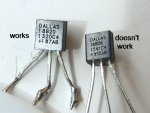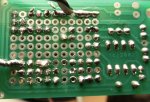In my first foray into using the DS18B20 (to avoid calibrating thermistors and adding the necessary pots to the circuits) I am not getting any debug result. This is the simple test code
The LED on C.1 flickers at the expected rate without any delay that would be expected from the sensor processing (the "up to 750 ms" in the datasheet). The debug shows 450 for w0 and 0 for w1. When I removed the sensor and connected a 4.7K resistor between the data (orange) wire and ground, thus creating 4.7K / 4.7K voltage divider and changing the code to readadc C.4 I debugged the expected w1 = 124. There is 4.95v across the outer terminals of the sensor.
I've attached a PDF showing the board layout and some shots of the actual circuit.
EDIT - the chip engraving is "Dallas / 18B20 / 1241C4 / +950AB"
View attachment Temp circuit 1Apr15.pdf
Regards
Nelson
Code:
Main:
let w0 = 450
readtemp12 C.4,w1
debug
high C.1
pause 20
low C.1
pause 50
goto mainI've attached a PDF showing the board layout and some shots of the actual circuit.
EDIT - the chip engraving is "Dallas / 18B20 / 1241C4 / +950AB"
View attachment Temp circuit 1Apr15.pdf
Regards
Nelson
Last edited:


